With their unusual appearance and allergy-friendly credentials, hairless cats can be a wonderful addition to any home. You might already be familiar with the Sphynx cat, but did you know there are many other options to choose from?
If you’re considering bringing one of these distinctive pets into your home, or just curious about these unique felines, look no further. Below, we run through seven hairless cat breeds you should know.
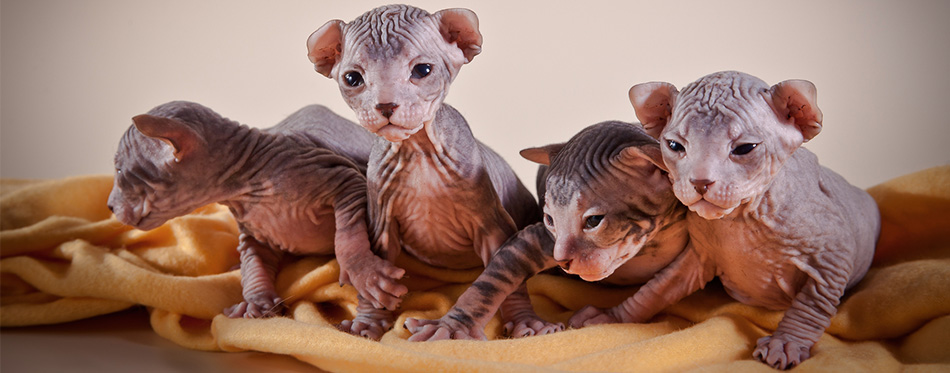
Why Choose a Hairless Cat?
Besides their distinctive looks and diverse personalities, there’s one particularly good reason why you might choose to adopt a hairless cat.
Thanks to their virtually hair-free bodies, they’re a wonderful pet for people who suffer from fur allergies. Without a thick coat, they secrete less of the protein that triggers allergic reactions in some people.
This lack of coat also makes for less vacuuming, less lint rolling, and, of course, less brushing.
Things to Know About Hairless Cats
Although they’re the perfect fit for some homes, there are a few things to bear in mind when adopting a hairless cat:
- Some allergy sufferers may still have a reaction from hairless cats
- Hairless cats require regular bathing to care for their exposed skin
- You’ll need to be careful with sun exposure, and typically keep them as indoor cats
- They can be a lot more expensive than other breeds
- Because of their fast metabolisms, these breeds require larger portions than their furry counterparts at mealtimes
That being said, hairless cats can be a perfect option for many households. Below are seven of our favorite hairless cat breeds.
Sphynx
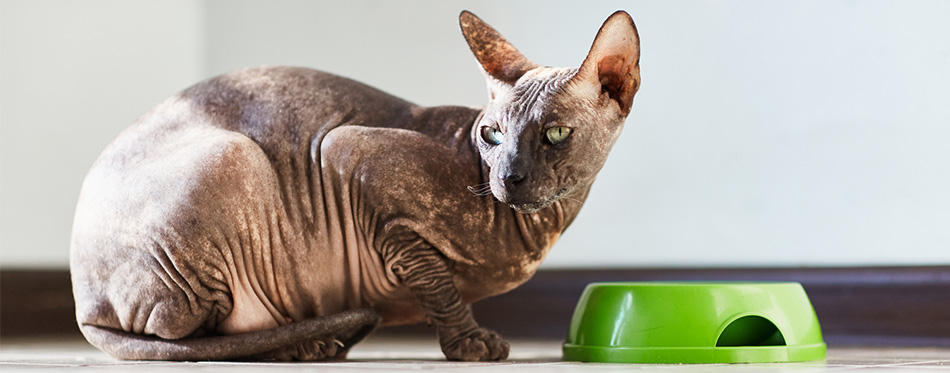
Named after the ancient Egyptian creature, the Sphynx cat is probably the best-known hairless breed.
These cats have the stats to back up this popular status, too. In 2016, the Cat Fanciers’ Association ranked Sphynxes as the eight most popular breed world wide.
Despite the name, Sphynx cats can trace their origins back to Canada, rather than Africa. Back in 1966, a hairless kitten was born in Ontario, beginning a breeding program that resulted in the Sphynx.
They’re characterised by their wrinkly skin, large ears, and big blue eyes. Overall, these cats have an adorable and almost comical appearance.
Unlike many breeds of hairless cat, the Sphynx comes in all sorts of patterns and colors. Their pink skin is often dappled with dark patches, sometimes in tabby or tortoiseshell patterns.
These cats are sweet, and highly sociable, unlike many of their furry counterparts. They’re also a vocal breed who will ‘talk’ to their owners as they go about their day.
Although the Sphynx is generally a healthy breed, would-be owners should be wary that they are sometimes prone to heart problems.
Elf
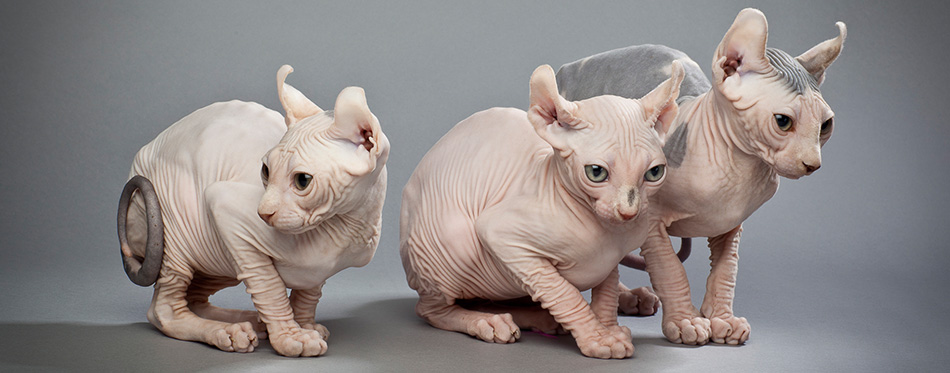
The next hairless cat to make our list is the mysterious Elf. This very new, and very rare, breed came about when cat enthusiasts in the US crossed a Sphynx with an American Curl.
The result? A cat that’s hairless like a Sphynx, and in possession of the American Curl’s distinctive curled ears. The elf has an athletic body and prominent cheekbones, lending them an air of elegance. They’re a tad less wrinkled than their Sphynx ancestors, but do have areas of wrinkling around their shoulders, muzzle, and ears.
Along with their appearance, these cats have also inherited the winning personality traits of both their parents. Like the Sphynx, they are affectionate, sociable, and outgoing. Like the American Curl, they are energetic, playful, and love to climb.
Because of their social nature, it’s best to avoid leaving an Elf cat alone for too long. If your home tends to be empty for long stretches of time on a regular basis, it’s best to adopt another sociable cat as the Elf’s companion.
Donskoy
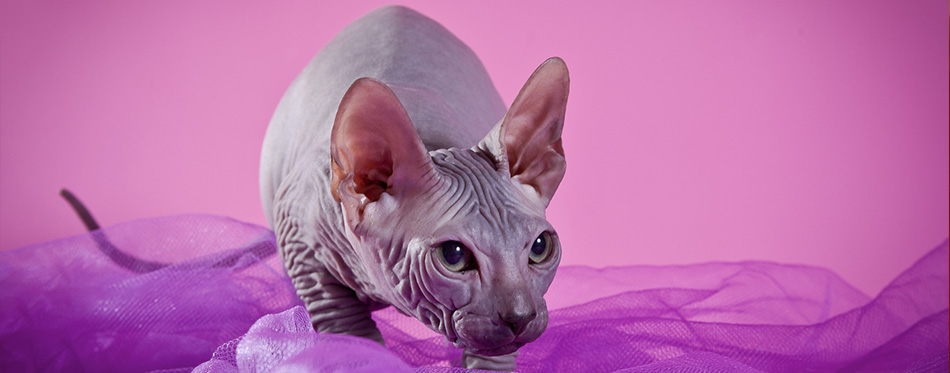
One of the most intelligent felines around, the Donskoy is a great hairless breed for cat lovers who want plenty of interactive play.
Originally discovered in Russia, the Donskoy, sometimes known as the Don Sphynx, is actually named after the river Don in Rostov. Here, a cat lover rescued a kitten from abuse at the hands of a group of boys, and discovered that the cat and some of its kittens naturally lost hair over time.
Later, a professional breeder picked up on this genetic mutation, and created the Donskoy breed we know today. The breed was officially recognized by the World Cat Federation in 1987.
Unlike other hairless varieties, the Donskoy sometimes has patches of longer hair around their legs, tails, and face. They’re medium sized, with a muscular build, and have wedge-shaped heads with large ears and almond shaped eyes.
As far as color and markings are concerned, the Donskoy expresses great variety. Their eyes can be any color, too.
The Donskoy is a breed that’s often said to have the personality of a dog. They’re sociable, loyal, highly intelligent, and surprisingly easy to train and teach tricks.
Ukranian Levkoy
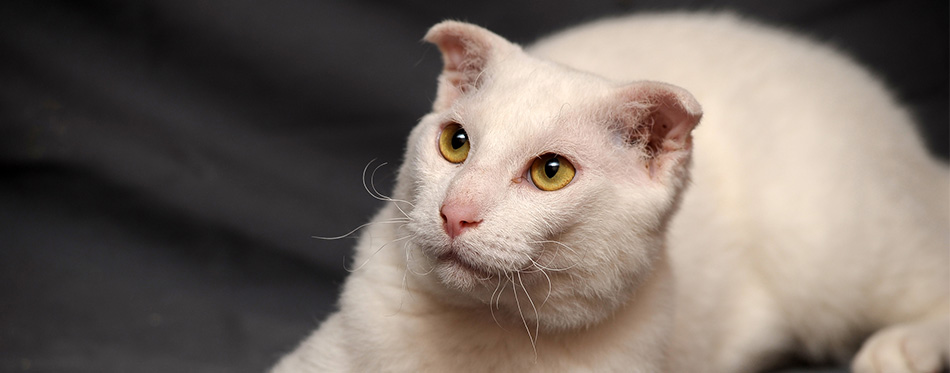
Many types of hairless cats are actually cross-breeds, like the Ukranian Levkoy, the next entrance on our list.
This breed’s parents are the Donskoy, and the Scottish Fold. Unlike some ‘hairless’ breeds, the Levkoy is, indeed, totally hairless. They also have the distinctive bent-forward ears of the Scottish Fold, giving rise to a truly unique-looking animal.
The Ukranian Levkoy was only created recently, in 2004. As the name suggests, these cats originate in Ukraine, where a professional breeder decided to create a hairless cat with adorably folded ears.
The breed’s name, Levkoy, comes from the levkoy plant, which has bent leaves—just like this cat’s ears.
In terms of temperament, the Levkoy makes a relaxed pet that gets along well with other animals, and people. Laid back as they are, the Ukranian Levkoy can be a little vocal, just like the Sphynx.
They love to play, and will become bored and mischievous without enough mental stimulation – be warned!
Peterbald
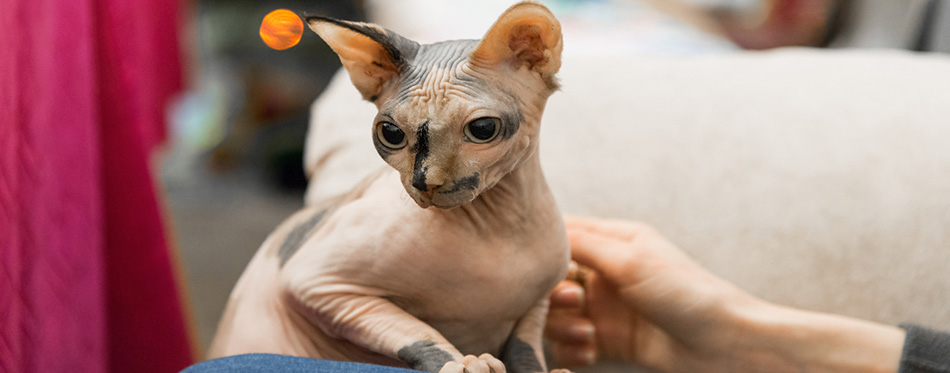
Put together a Donskoy and an Oriental Shorthair, and you’ll end up with the highly distinguished Peterbald. Like the Donskoy, they can trace their roots back to Russia, and became popular quickly in their native St Petersburg in the 1990s.
With the seal-like face of a Siamese cat, and the peach-fuzz hair of the Donskoy, this adorable feline is a bastion of elegance and poise.
The Peterbald is a medium sized breed that makes a great indoor cat, with long slender legs and a well-proportioned, athletic body.
Like their Donskoy parent, the Peterbald is a very affectionate cat. A little less excitable than the Donskoy, they like to sit quietly with their human family, even curling up under the covers at bedtime, and sitting nearby during meals.
They also have a wide inquisitive streak that, paired with their trusting nature, allows them to get along well with other pets in the house. Peterbald cats also tend to be unfazed by children and strangers, making them a great option for families who host a lot of guests.
Bambino
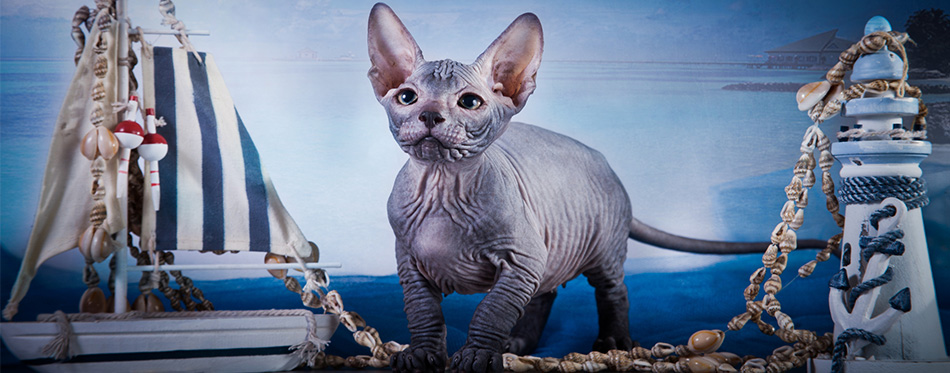
The linguists among you might have already cottoned on that ‘bambino’ is Italilan for ‘baby’, and that’s exactly what this affectionate breed is to their families.
Bambinos are the result of cross-breeding two better-known hairless varieties: the Sphynx, and the Munchkin. Like the Munchkin, they’re classified as a dwarf breed, characterised by short, strong legs coupled with a long back. This stature gives them the appearance of a kitten, which is how they got their name.
The breed is usually peachy in color, but sometimes other colors and patterns appear.
Bambino cats were first bred in 2005, so they’re a relatively new contender for our affection. With their loving and playful disposition, though, they’ve already earned their place in the heats of cat lovers the world over.
These cats are great for homes with children, because of their gentle nature, and their penchant for play is coupled with impressive agility for their size. With a Bambino at home, you’ll need to ensure any people food is well out of reach, as they’re known for leaping onto kitchen counters in search of tasty scraps.
Dwelf
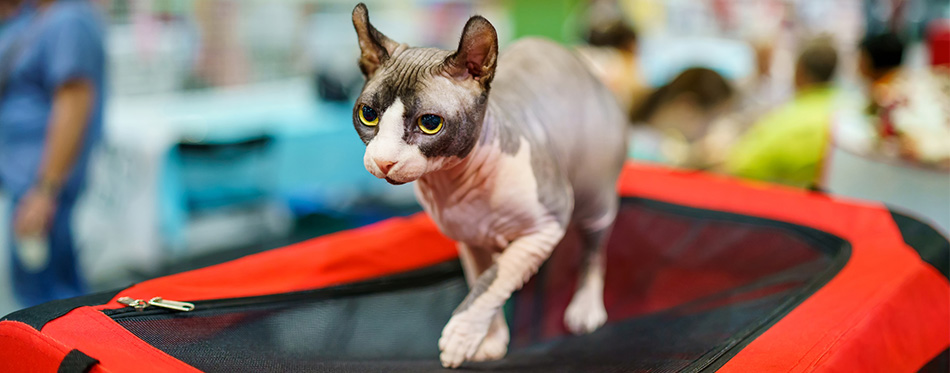
As the name suggests, the Dwelf is a dwarf Elf. This breed was developed by crossing an Elf cat with a Munchkin cat, resulting in a breed that’s stocky and sweet.
This cat inherited its smooth, peach-fuzz skin from the Elf, and its distinctive stature from the Munchkin, resulting in an unusual but adorable pet. Like most dwarf cat breeds, the Dwelf has short legs, and a relatively long body.
They have curled ears, no hair, and a wedge-shaped head resembling one of their close ancestors, the Sphynx. Most Dwelf cats are grey or cream in color, with the odd cat straying into white.
Despite their small stature, the Dwelf has a big personality. They love socialising with people, and can even get along with dogs if they’re introduced safely and gradually.
Thanks to an inquisitive nature, the Dwelf’s small size doesn’t prevent them from climbing all over your home, either!

